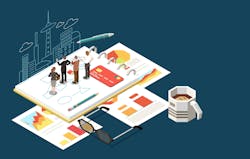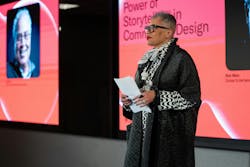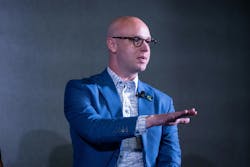Certified Design Futurist Program Helps Interior Designers Cultivate Foresight and Strategic Skills
It’s no secret that the design industry is evolving fast. From demographic shifts to technological advancements, designers are navigating a world that demands adaptability and, well, foresight. That’s where IIDA’s Certified Design Futurist (CDF) program comes in. The certification course is based on the methods of renowned quantitative futurist Amy Webb, founder and CEO of the Future Today Institute (FTI), which partnered with IIDA to create an innovative curriculum for design professionals. The unique, 12-week course equips designers with foresight skills and tools to anticipate future challenges and create solutions that meet the needs of a changing world.
The Case for Foresight
Strategic foresight isn’t just a buzzword—it’s a key business advantage that dovetails with the work designers are already doing. Designers are inherently creating spaces for the future, but those skills of foresight have never before been formalized and shaped into a recognized competency that is career-building and scope-enhancing for firms. FTI, an advisory firm specializing in foresight, uses its proven quantitative model to help organizations develop strategies that drive long-term success and resilience—and has now adapted its methodology to fit within the design process.
“Which is better? The ability to see the future, or the ability to create and execute the right strategy?” asks Webb in a Harvard Business Review article. She says the answer is clear: “Strategy and foresight were once the same discipline. And they should be again.” She’s right.
Here’s why foresight is crucial for designers.
Organizations move slowly. External change doesn’t. The pace of change in today’s business environment often outstrips the ability of organizations to keep up. Foresight equips designers and clients to anticipate and adapt, allowing them to ride the waves of change rather than be swept away.
Design is inherently future-focused. Every design project looks ahead—delivery may take years, and the best designs stay relevant for years beyond. The CDF program quantifies design’s inherent foresight, turning intuition into a valuable, strategic skillset.
Foresight is a method to break free from “task prison.” Foresight frees designers from the reactive cycle of immediate tasks, making room for innovation, creativity, and growth. It’s about cultivating a vision that drives informed strategic choices for you and your clients.
Understanding Emerging Trends Empowers Designers
Keeping up with change and future-proofing projects is key to design work. The U.S. centenarian population is projected to more than quadruple over the next 30 years, according to the Pew Research Center. As people live longer, designers will need to create spaces that accommodate aging populations—prioritizing accessibility, safety, and intergenerational living.
Another notable recent finding: Technology is everywhere, but stats confirm growing wariness surrounding it—about half of Americans are more concerned than excited about AI’s growing role in daily life, Pew found. Savvy designers will find ways to integrate advanced technology into spaces without losing the human touch.
Meanwhile, climate change is another pressing issue, and U.S. adults are deeply concerned. Sixty-one percent of Americans worry “a great deal” about climate change or global warming, according to Gallup, and 45% believe global warming will pose a serious threat to them in their lifetime. That’s not without reason—the three hottest days on record occurred in July 2024, according to the United Nations, and greenhouse gases have surged to a record high. Public demand for sustainable practices is only growing, and designers are increasingly finding innovative ways to reduce environmental impact while maintaining functionality and aesthetics, making sustainability a cornerstone of future-ready spaces.
The CDF program trains participants to identify and address environmental and societal shifts by examining 11 macro sources of change—from shifts in demographics, governments, and wealth distribution to climate and technological changes—to foresee, and prepare for, plausible futures.
Why This Matters
CDF is more than a certification—it’s a way to future-proof your career. Certified Design Futurists will have the knowledge and tools to help clarify how people, clients, businesses, and users will behave, and what their needs will be in the coming decades, and then approach projects accordingly to create prescient, human-centered, resilient design work. Ready to step into the future? Learn more about how the program can expand your skills and services on the IIDA website.


